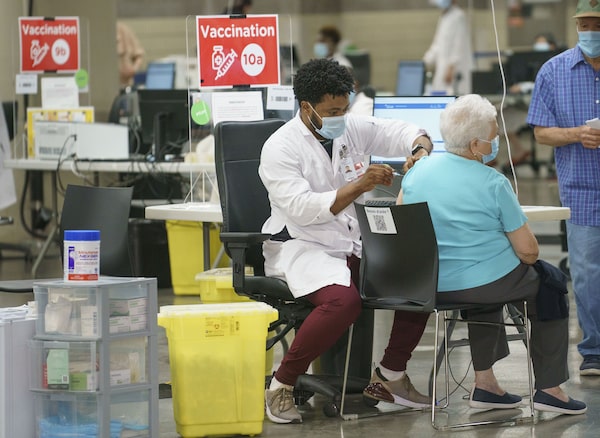
A woman is vaccinated at a COVID-19 vaccination clinic in Montreal on June 21, 2021.Paul Chiasson/The Canadian Press
Nathan Stall is a geriatrician at Sinai Health in Toronto and assistant scientific director of Ontario’s COVID-19 Science Advisory Table. Fahad Razak is a general internist at St. Michael’s Hospital and assistant professor at the University of Toronto. Andrew Morris is an infectious diseases physician at Sinai Health and the University Health Network and a professor at the University of Toronto.
After a slow start, Canada leads the world for administering at least one dose of a COVID-19 vaccine, with roughly two thirds of the population partially or fully vaccinated. However, our country’s life-saving “first dose fast” strategy means that only 8 million or 21 per cent of Canadians are fully vaccinated. With Canada receiving millions of vaccine doses a week, hundreds of thousands of individuals are now receiving their second doses daily.
In spite of this, the Public Health Agency of Canada has determined that they will not issue any distinct guidance for the fully vaccinated until the fall when cases are lower and two-dose vaccine coverage is higher. They have only recommended lifting restrictions for everyone at once based on population-level vaccination metrics that move us closer to herd immunity.
Canada’s unwillingness to give individual-level rather than population-level guidance seems ill-advised. Consider that the U.S. Centers for Disease Control and Prevention (CDC) issued public health recommendations for the fully vaccinated back on March 8, when the United States had a lower percentage of its population fully vaccinated (9.4 per cent) than we currently do.
While 88 per cent of Canadians are now willing to receive the COVID-19 vaccine, we need to incentivize everyone to receive the vaccine as soon as offered. One crucial strategy is to show them how life will change with vaccination. Further, in the absence of public health guidance, understandably impatient Canadians will start to make up their own rules, potentially risking control of the pandemic and the safety of others at exactly the time the more transmissible and severe Delta variant is on the rise.
Knowing how effective vaccines are at both preventing COVID-19 infection, severe illness and viral transmission, it makes little scientific sense to have all Canadians following the same public health restrictions. Loosening public health restrictions for the fully vaccinated and maintaining them for the partially and unvaccinated might be seen as an assault on Canadian solidarity and the sense that “we’re all in it together.”
Yet consider that most fully vaccinated Canadians are 80 years of age and older, a group that has experienced extreme loneliness and social isolation. Many of these older adults have limited life expectancies and cannot necessarily wait until the fall when everyone else has had the opportunity to get vaccinated.
Others worry that individual-level guidance will perpetuate inequities in access to COVID-19 vaccines, but consider that approaches such as Ontario’s hot-spot strategy saw residents of higher-risk neighbourhoods being most likely to receive first vaccine doses. Finally, all Canadians will have the opportunity to be fully vaccinated by late summer – are we really going to hold everyone back for two to three months so that we all move together? That would be very Canadian but would exacerbate accumulating economic and societal hardships.
So, what would individual-level guidance look like for the fully vaccinated? First, we need to clearly tell fully, partially and unvaccinated Canadians which settings and activities they can safely participate in, and with what precautions. The CDC guidance would be a reasonable starting point, by allowing fully vaccinated individuals to resume most activities without masking or physically distancing, except for public indoor spaces such as businesses or workplaces.
Second, we should start allowing fully vaccinated individuals access to higher transmission settings and activities, such as indoor dining, gyms and religious services. In most provinces and territories these won’t be allowed to reopen until later in the summer when two-dose vaccine coverage is higher. Jurisdictions like Israel and New York State have allowed fully vaccinated people into these settings by having them present vaccine certificates. Some form of vaccine certification is inevitable in Canada, and governments would be wise to implement their own systems before private corporations do, which could lead to problems with equity and privacy.
Finally, individual vaccination status should play a far greater role in loosening restrictions on travel. Canada has recently announced that it will eliminate the quarantine requirement for fully vaccinated returning travellers who are Canadians citizens or permanent residents. But implementation has been delayed until July, and there is no allowance for fully vaccinated visitors to Canada. Discouraging the fully vaccinated from entering our borders will continue harming family reunification, border tourism and the livelihoods of Canadian businesses, all with no clear public health benefits.
Now more than 15 months into the COVID-19 pandemic, and with widespread access to incredibly effective vaccines, Canada should be less blunt and population-based in its application of public health restrictions. This should start with individual guidance for the fully vaccinated.
Keep your Opinions sharp and informed. Get the Opinion newsletter. Sign up today.